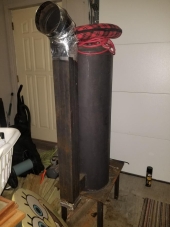Bridget wrote:
So this incredible stove....that I would love to learn more about seems to use quite a bit of stove pipe - where are good sources of this? I have looked for stove pipe for my woodstove that I need to get set up before winter and it is extremely expensive. The rocket stove is toted as being economical, but this one item seems to throw it off...(hundreds of $). It seems to be the hardest to get reclaimed...does it need to be stainless steel?
The Rocket Mass Heater was designed to be built with widely available scrap materials.
It's not legal to sell "used stovepipe" in the US, because of fire safety issues in re-installing damaged or creosote-coated stovepipe. But it is legal to sell it as scrap metal, and buy it as such.
For our purposes, the stovepipe or ducting can be viewed as a form, or liner, for a non-combustible, monolithic, earthen masonry mass. Small holes or rust spots, if properly sheathed in thermal cob, will self-seal when the clay gets wet.
If you go shopping for scrap metal, don't say "I'm building this stove" - they can't sell you anything for that purpose. Instead, describe your need as "forms for a clay project" and the ideal metal shape as similar to stovepipe or ducting in whatever diameter you need.
(Do try to avoid rusty, damaged, or corrugated metal parts, since they will be less strong and more dangerous to work with during the installation phase.)
Stainless or stovepipe is preferable to galvanized for the first few sections, since exhaust temperatures may be hot enough to vaporize some harmful metals from the surface of galvanized ducting. I tend to avoid aluminum in the first few sections too, because it's designed for low-temperature applications. After the first 8-12 feet from the stove, almost any metal will work. If you can't find quite enough pieces, you can fudge in a few sections by building a brick tunnel or corner. Brick is not ideal for our purposes here, it tends to slow the gas flow, but it gets the job done.
We are still working on what materials might be needed to install a Rocket Mass Heater "up to building code."
The ASTM specs for a "masonry heater" mostly work for a rocket mass heater too. (Remember to allow extra clearance from the barrel, as you would for a woodstove). But one of the key differences is that the code describes ceramic chimney-liner as the flue liner. With a 1-inch gap to the masonry heat exchange mass. This does not seem to me like a technology that will work for a rocket stove, but if anyone has ceramic chimney liner lying around to play with, I'd love to hear how it works for you.
If you are in an area where you need a permit to install your rocket mass heater, you may need to specify all-new stovepipe or ceramic chimney liner to satisfy your local officials. Chalk it up as one more cost of living on good terms with Big Brother.
Rocket Mass Heaters are cheaper than Masonry Heaters in almost any configuration, and provide much the same quality of heat. The barrel is slightly less durable than your average masonry heater components, but it also provides something they do not: immediate comfort from quick radiant heat.
Rocket Mass Heaters can be as cheap as a woodstove, or cheaper, but the tradeoff is the amount of time spent sourcing scrap parts and building the installation. Woodstoves or Pocket Rockets can be a better solution for quick-and-dirty heat in a weekend getaway or occasional use space.
































